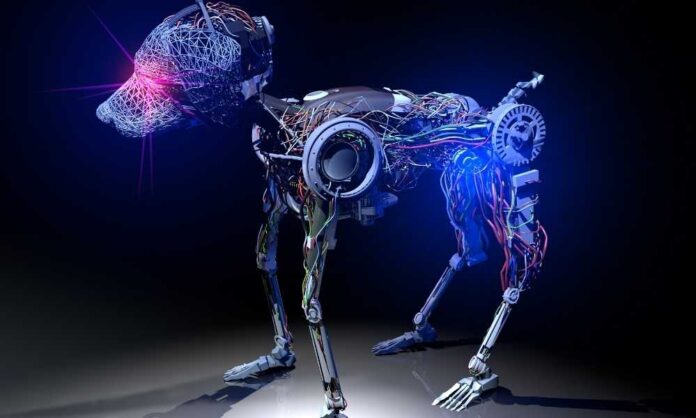Hauling items from place to place may not have been the dramatic robot revolution we envisioned in our childhood – it may seem a little too simple, too regular, not quite cool enough. However, in actuality, it’s tasks with these exact qualities – tedious, repetitive, time-intensive – that reap the most rewards from automation.
Enter the Autonomous Mobile Robot (AMR). Though not as glamorous as their humanoid counterparts, these tugging, pushing, self-navigating machines might be the real unsung heroes of the robotics revolution. Today, AMR robots are emerging from behind the scenes of industries as diverse as manufacturing, logistics, healthcare, and agriculture. Their mission? To streamline processes, enhance efficiency, and redefine productivity.
What are Autonomous Mobile Robots (AMRs)?
Autonomous Mobile Robots, shortened to AMRs, are self-navigating machines that map, route, and travel their surroundings without infrastructure add-ons or human guidance.
Instead, AMR robotics are equipped with sensors that collect distance data on objects in their vicinity. This data is processed by onboard artificial intelligence (AI) algorithms to generate a real-time map of the mobile robot’s environment. AI also plans the robot’s route, avoids surprise obstacles, and continuously updates the map as new data comes in.
1. Autonomous Mobile Robots (AMRs) vs. Autonomous Guided Vehicles (AGVs)
This level of autonomous robotic navigation is what sets AMRs apart from other solutions – most notably their recent predecessors: the Autonomous Guided Vehicles (AGVs).
Guided vehicles, as their name suggests, need guidance. They follow predefined routes, typically marked by wires or magnetic tape, to transport items throughout facilities. However, if an unexpected obstacle appears in their path, AGVs lack the capability to navigate around it. They simply stop and wait for human intervention.
AMRs, conversely, adapt to their dynamic environments instantly and independently. They make real-time decisions to stop or reroute based on split-second interpretation of their sensor data, completing assigned tasks regardless of interference.
AMRs are a step higher on the autonomy scale than AGVs. With the intelligence to adapt, they avoid process interruptions and eliminate the need for human oversight. This level of autonomy allows AMRs to work around the clock, ensuring that operations can run 24/7
2. Benefits of Autonomous Mobile Robots
Autonomous robots benefits extend beyond efficiency boost toward a new era of productivity and safety. They offer cost-saving automation, real-time data collection, and space optimization, all while promoting human talent and fostering a greener work environment.
Mobile robots have helped businesses realize advantages such as:
- Efficiency Boost: AMRs automate repetitive tasks, thus increasing overall productivity.
- Risk Reduction: They operate in hazardous environments, reducing human exposure to potential risks.
- 24/7 Operation: AMRs can work round-the-clock without fatigue, ensuring continuous productivity.
- Adaptability: They adjust to dynamic environments, seamlessly navigating through changes.
- Cost-Saving: By automating tasks, AMRs save on labor costs and reduce errors.
- Real-Time Data Collection: AMRs collect and analyze data in real-time, providing valuable insights for business decisions.
- Space Optimization: AMRs’ compact design and ability to navigate tight spaces can maximize facility space usage.
- Promotion of Human Talent: By handling mundane tasks, they free up human workers for more complex and creative duties.
- Reduced Training Time: AMRs, being self-learning, reduce the time and cost associated with employee training.
- Eco-Friendliness: With electric operation, AMRs contribute to a greener, more sustainable work environment.
Types of Autonomous Mobile Robots
Autonomous robots are varied, with their utility hinging on specific applications. Picking robots and self-driving forklifts are leading the charge in warehouse and manufacturing efficiency. Delivery robots and drones are pushing boundaries in logistics and aerial operations., Hospitality and disinfection robots are innovating in customer service and hygiene standards.
1. Picking Robots:
These robots are the epitome of efficiency in warehouse and distribution centers. They automate the picking process involving retrieving items from shelves or bins. This task, often mundane and time-consuming for human workers, is tackled with precision and speed by these robots, reducing errors and increasing productivity.
2. Self-Driving Forklifts:
Autonomous machines have transformed material handling in manufacturing facilities and warehouses by increasing safety levels and operational efficiency. Equipped with sensors and AI algorithms, they transport heavy goods safely and efficiently, without human intervention.
3. Autonomous Inventory Robots:
AMR robots navigate aisles independently, scanning barcodes to keep track of inventory. This not only enhances accuracy but also frees up human employees for more complex tasks, revolutionizing inventory management.
4. Delivery Robots
From food delivery to parcel delivery, AMRs navigate sidewalks and streets autonomously, ensuring timely and contactless delivery. Their application has spiked especially during the COVID-19 pandemic, demonstrating their potential in maintaining operations amidst disruptions.
5. Hospitality Robots
AMRs handle tasks like room service, cleaning, and reception duties, enhancing customer experience while reducing operational costs. They’ve been commonly noticed in high-end hotels and restaurants, offering a unique customer experience.
6. Disinfection Robots
In the wake of COVID-19, these robots are prominent in healthcare and public spaces. They autonomously disinfect areas using UV light or sprays, reducing the risk of infection transmission, maintaining hygiene standards during challenging times.
7, Drones
Drones, or Unmanned Aerial Vehicles (UAVs), have applications from aerial photography to disaster management. They’re particularly impactful in agriculture, where they monitor crop health and apply pesticides. Their reach to inaccessible areas has created new possibilities across sectors, including entertainment, real estate, and emergency response.
Industries That Use Autonomous Mobile Robots
The impact of mobility robots, autonomous and otherwise, was first felt by sectors such as manufacturing and logistics. This was due to the volume of items these sectors manage, coupled with the expansive space within warehouses for navigation and greater financial capacity to invest in such technology.
As knowledge and resources continue to expand and production cost of these robots decreases, AMRs are now making their mark in incredibly diverse fields:
- Manufacturing: AMRs enhance precision and speed in assembly lines, maximizing productivity and minimizing errors.
- Logistics: In warehouses, AMRs automate the picking and delivery process, boosting efficiency and reducing labor costs.
- Healthcare: AMRs assist with medication distribution and disinfection routines, improving patient care and hygiene standards.
- Agriculture: Farming AMRs handle tasks like crop monitoring and harvesting, increasing yield and optimizing resource usage.
- Hospitality: From room service to cleaning, AMRs elevate customer experiences while streamlining operations.
Autonomous Mobile Robot Companies to Know
Aethon:
Based in Pittsburgh, USA, Aethon specializes in developing autonomous mobile robots (AMRs) for intralogistics in healthcare, manufacturing, and hospitality sectors. Their flagship product, the TUG robot, effectively automates internal logistics, freeing staff for higher-value tasks.
Dusty Robotics:
A Californian start-up, Dusty Robotics focuses on revolutionizing the construction industry. Their robot, FieldPrinter, automates layout tasks on construction sites, enhancing accuracy while reducing time and labor costs.
Fetch Robotics:
Fetch Robotics, based in San Jose, USA, offers an extensive range of AMRs for material handling and data collection. Their solutions help warehousing and intra-logistics to meet their automation needs efficiently and safely.
iRobot:
Based in Bedford, Massachusetts, iRobot is renowned for its consumer robots, such as the Roomba vacuuming robot and the Braava mopping robot. These innovations automate household chores, freeing up time for users.
Locus Robotics:
Located in Wilmington, Massachusetts, Locus Robotics specializes in autonomous mobile robots warehouse
automation. Their mobile robots enhance productivity and efficiency in logistics operations, revolutionizing the way goods are moved and stored.
MHS Global:
Headquartered in Mt. Washington, Kentucky, MHS Global provides comprehensive material handling automation solutions. They offer services from system design and fabrication to installation and maintenance.
Milvus Robotics:
Milvus Robotics, based in Ankara, Turkey, designs and manufactures ground robots for various tasks, including transport, inspection, and surveillance.
Check out: E-Waste Instructables Robot
Mobile Industrial Robots (MiR):
Situated in Odense, Denmark, MiR offers flexible and user-friendly mobile robots in transportation to automate internal delivery and logistics across multiple sectors.
OTTO Motors:
A division of Clearpath Robotics, OTTO Motors is based in Kitchener, Canada. They provide self-driving vehicles for material handling inside manufacturing facilities, warehouses, and distribution centers.
Quasi Robotics:
Quasi Robotics specializes in advanced service robotics, creating smart humanoid robots that enhance both personal and professional tasks. Focused on safety, efficiency, and innovative human-robot collaboration, they’re reshaping the future of automated assistance.
Robotnik Automation:
Robotnik, headquartered in Valencia, Spain, designs, manufactures, and markets mobile robot solutions. Their products are used in research and development, industrial applications, and defense and security.
Skydio:
Situated in Redwood City, California, Skydio is a trailblazer in autonomous flight technology. They design and manufacture drones that navigate independently, finding applications in sectors like construction, public safety, and defense.
Starship Technologies:
Headquartered in San Francisco, California, Starship Technologies develops small self-driving delivery robots. These robots deliver goods locally in a convenient and eco-friendly manner.
Techmetics Robotics:
Techmetics Robotics, headquartered in Singapore, offers service robotics solutions. Their robots for hospitality, healthcare, and manufacturing, automate tasks like room service delivery and patient care.
Conclusion
Autonomous Mobile Robots (AMRs) have transformed mundane tasks into automated processes, freeing human resources for more complex endeavors. They come in varied forms, each with unique capabilities and applications and each proving their versatility in industries from logistics to healthcare.
Companies pioneering in the AMR robot field are setting new standards in efficiency and productivity. While the tasks AMRs undertake might seem ordinary, their impact is anything but. For those interested in exploring further, Quasi Robotics offers a wealth of information on AMR technology at www.quasi.ai.
Check out: Comparison Between RPA and Test Automation


